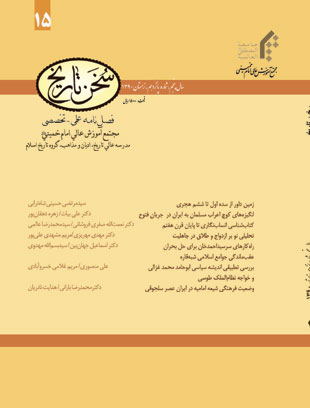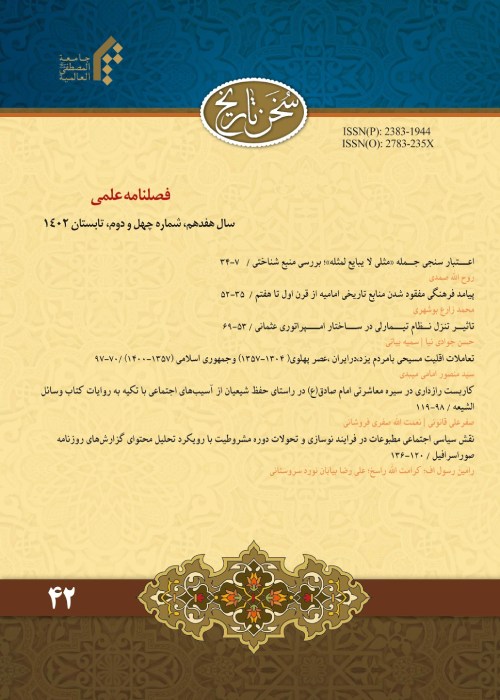فهرست مطالب

نشریه سخن تاریخ
پیاپی 15 (زمستان 1390)
- تاریخ انتشار: 1391/05/10
- تعداد عناوین: 7
-
Page 3Zamindawar is a geographical area in Khorasan and the great Sistan;currently it is the border lands in Afghanistan. According to the sources, natural, political, economy and cultural geography and anthropogeography aspects of this region considered highly important in primitive centuries of Islam.In present paper, firstly the geographical situation of Zamindawar will be explained, considering its neighbors: Bast, Arachosia and Ghor. In analyzing natural geography of the area, the ecosystem and running waters will be analyzed. In anthropogeography, native habitats and buildings will be introduced according to historical data. Following this section, political geography of the area will be discussed. From the triple phenomena of political geography realm and government of Zamindawar in the first six centuries will be analyzed. In Economic geography section, the main economical products will be explained. Finally in cultural geography,religion of the inhabitants in pre-Islamic era will be discussed.This research is done with historical approach and documentary and analytical- descriptive method. The present paper is the first independent research about Zamindawar. Although some researches about historical geography of Islamic territory are carried on, an independent research on this subject is not written in Farsi.Keywords: Bast, Sistan, Khorasan, Zamindawar, Dawar lands, anthropogeography, cultural geography, Ghor
-
Page 21Immigration of Arab tribes to Persia in Islamic era was concurrent with conquest of this country which led to a new chapter in history, culture and civilization Persia. The main question of the present paper is the motivations of Arabs in immigrating to Persia and also the consequences of immigration,mixture and marriage between Arabs and Persian people.The present papers will analyze different motivations of Arab in immigrating to Persia and the main reason is religious motivations in the time of Caliphates and Umayyad era. Jihad and preaching Islam were the main motivations of Muslims and the origins of such motivations were in Quran and Sunnah. Also they had military and political motivation in conquering Persia in order to continue their conquests and overcome their economic and social problems. Therefore military forces, their commanders and their families and tribes were the first immigrants in Persia. Mentally,financial motivations and taking war booties should be prior to the other motivations. The mentioned motivation became the main reason in conquering the east of Persia while jihad and preaching Islam became less important. Many of Shia Muslims, Sayyeds, Alavian, Kharijites and government oppositions and those who were attributed to them immigrated to Persia to save their lives and their property. Welfare motivations were subsequent to financial motivations which were a different kind. After settlement in Persia, getting accustomed to their lifestyle and their mixture with native people, welfare motivations came up in minds.Keywords: Motivations of Arabs in immigration, conquests, Persia territory, the consequences of immigration
-
Page 43
Intellectuals like Marashi Najafi, Umar Rida Kahhalah, Abd al-Razzaq Kamuneh, Strstein and Aeenehvand tried to make a list of genealogical books written by Islamic genealogists using rejal books, al-Fehrest and al-Ansab. This effort was made since these books were suffering from lack of comprehensiveness and maneiyyah (exclude others), repetition and overlap.The main reason of such deficiencies is that the authors of genealogical books did not make reference to all of the existing sources which could be useful in making a comprehensive list. Through a complete research using primary sources and making comparisons between recent lists which are the background of the research, this paper will prepare a list of genealogical books in a diagram, so that we can deal with a part of remarkable Muslim books. By scanning this list, we can find out the topics which genealogists were interested in and also the connection between genealogy and other sciences like historiography, rejal, hadith (traditions) and also development of genealogy in the first seven centuries of Islam. As a statistical and bibliographical analysis, the above-mentioned list can be used as a basic study in genealogy. It is also useful for future researches in this field.
Keywords: Genealogical books, bibliography, genealogist, Islamic genealogy -
Page 77Family is one of the most important social institutions of humans throughout history and among all nations and tribes. Considering geographical, economic and cultural situations, Jahiliyyah3 had its own specific laws and functions. Family laws and conventions in Jahiliyyah era were the main reason that caused a low status for women in the society.This paper will deal with family type topics, such as different kinds of marriages and divorces, the number of spouses, relationship between wife and husband and also independence of women in making decisions about their marriage and divorce which would explain women’s status in the society. The author believes that a prevalent type of marriage is not accepted as a common type of marriage; and prostitution was considered as a wretched action in society. The paper shows that some girls were independent in making decisions about their marriage. While having several spouses was not considered a social value, the number of spouse was limited in Jahiliyyah era. It’s included in this paper that there were different types of divorces and women were independent in having divorce.Keywords: Family, Jahiliyyah, number of spouses, marriage, divorce
-
Page 103Sayyed Ahmed Khan was one of the distinguished scholars of Islamic societies in Indian sub-continent. He made great efforts to overcome the backwardness in Muslim societies and he proposed many solutions.After analyzing the background of Muslim societies in Indian subcontinent,this paper mentioned colonialism and their anti-Islamic policies as the main factor that intensified the decline of Indian Muslims. Afterward Ahmed Khan’s solutions to overcome this crisis will be explained. He proposed solutions including: Change in political behavior of Indian Muslims, rectification in cultural and intellectual deceitfulness and revert to true Islamic teachings. In order to achieve these goals he prescribed:Opening the door of Ijtihad3, logical and rational analysis of traditions’4 content, promoting scientific educations and new skills, reforming and promoting Urdu, compromise with British colonialism, teaching English language and holding educational Islamic conferences.The present paper is carried on by library sources, using books related to Islamic movements, India in colonialism era and reformists and modernists. Based on author’s research no background is found on this subject.Keywords: Islamic societies in Indian sun, continent, Sir Sayyed Ahmed Khan, Opening the doors of Ijtihad, Promoting scientific educations, skills, promoting Urdu, Learning English language
-
Page 125Saqifa (11 A.H/ 632 A.D) is considered symbolically important in history of political thought of Islam. Mentioning a tradition from Prophet about his successor chosen from Quraysh, was a crucial action that effect political thought of Islam. The theories “Qurayshi budan khaliphah” (caliphate was from Quraysh) and “Ahl e Hall va Aqd” (the group that choose the successor of caliph) are the most important results of Saqifa. Anyway the history of political thought of Islam had theories like Istikhlaf (choosing the successor of caliph), Istila (domination), Imamah and Saltant (kingship).The 4th and 5th centuries (10th and 11th A.D) in history of Islam are the golden age of Islamic civilization. Al-Mawardi, Khayyam, Ghazali and Nizam al-Mulk Tusi were living in this era. Political thought of Ghazali is dependent on religion and sect, while Nizam al-Mulk thought is based on siyasatnameh (The Book of Government, 479A.H / 1086A.D) which is obviously dependent on Iranian thoughts and it is inspired by Iranshahri political thought. Nizam al-Mulk doesn’t deal with theoretical discussions and their teachings on politics, but he mentioned the real matters which can be considered as the foundation of government. Inspired by the theory of “Fareh Izadi”, he dealt with kingship institution all over his book and he mentioned Khilafat institution fewer which is related to religion.On the other hand, justice is prior to religion in political thoughts of Nizam al-Mulk. Anyway, the theory of Fareh Izadi, justice, cohesion between land and religion are the main components of political thought of Iranshahri which are explained through siyasatnameh. However Ghazali and 1. PhD student in History of Iran (Islamic Era): Kharazmi University. Email:2. PhD student in History of Iran (Islamic Era): Shiraz University.Keywords: Political thoughts, history of Islam, Seljuk, Ghazali, Nizam al Mulk
-
Page 151While Imamiyyah blossomed in Buyid dynasty’s time with the supports of Shi’ite Emirs who were interested in culture, noticeably this process encountered some problems at the begging of Seljuk ruling by the strictness of bigot sultans and viziers like Nizam al-Mulk. Through analyzing the time sources, Shia Muslims contributions in building mosques, schools and libraries in Shiite cities such as Qom,Kashan, Rey, Aveh, Varamin, Sabzevar and Sari are quite obvious. It also demonstrates how young Shiite Muslims were scientifically and religiously trained. Especially because of competition between Nizamiyyah schools,they did a great job in training educated, scholar, poet and minister Muslims.Shia artists were pioneer in architectural styles of mosques, madrasah,minaret, pottery and handicrafts. On the other hand, educated Shi’ites influenced the court of Seljuk in developing Shia culture in Iran. In addition,cultural situation of twelvers in Seljuk era is analyzed through this paper.Keywords: Seljuk, Imamiyyah, Taqiyyah, culture, Iran, Madrasah


